Note
Go to the end to download the full example code.
0.05 Li2O • 0.95 SiO2 MAS-ETA¶
The following example is an application of the statistical learning method in determining the distribution of the Si-29 echo train decay constants in glasses.
Import all relevant packages.
import csdmpy as cp
import matplotlib.pyplot as plt
import numpy as np
from mrinversion.kernel import relaxation
from mrinversion.linear_model import LassoFistaCV, TSVDCompression
from csdmpy import statistics as stats
plt.rcParams["pdf.fonttype"] = 42 # For using plots in Illustrator
plt.rc("font", size=9)
def plot2D(csdm_object, **kwargs):
plt.figure(figsize=(4, 3))
csdm_object.plot(cmap="gist_ncar_r", **kwargs)
plt.tight_layout()
plt.show()
Dataset setup¶
Import the dataset¶
Load the dataset as a CSDM data-object.
# The 2D SE-PIETA-MAS dataset in csdm format
domain = "https://www.ssnmr.org/sites/default/files/mrsimulator"
filename = f"{domain}/MAS_SE_PIETA_5Li_95Si_FT.csdf"
data_object = cp.load(filename)
# Inversion only requires the real part of the complex dataset.
data_object = data_object.real
sigma = 1110.521 # data standard deviation
# Convert the MAS dimension from Hz to ppm.
data_object.dimensions[0].to("ppm", "nmr_frequency_ratio")
plot2D(data_object)

There are two dimensions in this dataset. The dimension at index 0, the horizontal dimension in the figure, is the MAS dimension, while the dimension at index 1, the vertical dimension, is the signal decay from relaxation.
Prepping the data for inversion¶
Step-1: Data Alignment
When using the csdm objects with the mrinversion package, the dimension at index
0 must be the dimension undergoing the linear inversion. In this example, we
invert the signal decay from relaxation, that is, dimension-1. The first step is to
swap the axes using a data transpose.
Step-2: Optimization
Notice, that the signal from the 2D SE-PIETA-MAS dataset occupies a small fraction of the two-dimensional grid. Though you may choose to proceed with the inversion directly onto this dataset, it is not computationally optimum. For optimum performance, trim the dataset to the region of relevant signals. Use the appropriate array indexing/slicing to select the signal region.
data_object_truncated = data_object[:, 1220:-1220]
plot2D(data_object_truncated)

Linear Inversion setup¶
Dimension setup¶
In a generic linear-inverse problem, one needs to define two sets of dimensions—
the dimensions undergoing a linear transformation, and the dimensions onto which
the inversion method transforms the data. For T2 inversion, the two sets of
dimensions are the signal decay time dimension (kernel dimension) and the
reciprocal T2 (inverse dimension).
data_object_truncated.dimensions[0].to("s") # set coordinates to 's'
kernel_dimension = data_object_truncated.dimensions[0]
Generating the kernel¶
Use the T2 class to generate a T2 object
and then use its kernel method to generate the T2 relaxation kernel..
relaxT2 = relaxation.T2(
kernel_dimension=kernel_dimension,
inverse_dimension=dict(
count=32,
minimum="1e-3 s",
maximum="1e4 s",
scale="log",
label=r"log ($\lambda^{-1}$ / s)",
),
)
inverse_dimension = relaxT2.inverse_dimension
K = relaxT2.kernel(supersampling=20)
Data Compression¶
Data compression is optional but recommended. It may reduce the size of the inverse problem and, thus, further computation time.
new_system = TSVDCompression(K, data_object_truncated)
compressed_K = new_system.compressed_K
compressed_s = new_system.compressed_s
print(f"truncation_index = {new_system.truncation_index}")
compression factor = 1.3333333333333333
truncation_index = 18
Solving the inverse problem¶
FISTA LASSO cross-validation¶
We solve the inverse Laplace problem using the statistical learning FISTALassoCV
method over a range of λ values and determine the best T2 parameter distribution for
the given 2D T2-MAS dataset.
# setup the pre-defined range of alpha and lambda values
lambdas = 10 ** (-4 + 5 * (np.arange(32) / 31))
# setup the smooth lasso cross-validation class
s_lasso = LassoFistaCV(
lambdas=lambdas, # A numpy array of lambda values.
sigma=sigma, # data standard deviation
folds=5, # The number of folds in n-folds cross-validation.
inverse_dimension=inverse_dimension, # previously defined inverse dimensions.
)
# run the fit method on the compressed kernel and compressed data.
s_lasso.fit(K=compressed_K, s=compressed_s)
The optimum hyper-parameters¶
Use the hyperparameters attribute of
the instance for the optimum hyper-parameters, $lambda$, determined from the
cross-validation.
print(s_lasso.hyperparameters)
{'lambda': 0.11601553017399714}
The cross-validation curve¶
plt.figure(figsize=(4, 3))
s_lasso.cv_plot()
plt.tight_layout()
plt.show()

The optimum solution¶
f_sol = s_lasso.f
levels = np.arange(15) / 15 + 0.1
plt.figure(figsize=(3.85, 2.75)) # set the figure size
ax = plt.subplot(projection="csdm")
cb = ax.contourf(f_sol / f_sol.max(), levels=levels, cmap="jet_r")
ax.set_ylim(-70, -130)
ax.set_xlim(-3, 2.5)
plt.title("5Li:95Si")
ax.set_xlabel(r"$\log(\lambda^{-1}\,/\,$s)")
ax.set_ylabel("Frequency / ppm")
plt.grid(linestyle="--", alpha=0.75)
plt.colorbar(cb, ticks=np.arange(11) / 10)
plt.tight_layout()
plt.show()

The fit residuals¶
To calculate the residuals between the data and predicted data(fit), use the
residuals() method, as follows,
residuals = s_lasso.residuals(K=K, s=data_object_truncated)
plot2D(residuals)

The standard deviation of the residuals is
<Quantity 1526.08674559>
Saving the solution¶
To serialize the solution (nuclear shielding tensor parameter distribution) to a file, use the save() method of the CSDM object, for example,
f_sol.save("5Li-95Si_inverse.csdf") # save the solution
residuals.save("5Li-95Si-residue.csdf") # save the residuals
Analysis¶
# Normalize the distribution to 1.
f_sol /= f_sol.max()
# Get the Q4 and Q3 cross-sections.
Q4_coordinate = -111.5e-6 # ppm
Q3_coordinate = -93.5e-6 # ppm
Q4_index = np.where(f_sol.dimensions[1].coordinates >= Q4_coordinate)[0][0]
Q3_index = np.where(f_sol.dimensions[1].coordinates >= Q3_coordinate)[0][0]
Q4_region = f_sol[:, Q4_index]
Q3_region = f_sol[:, Q3_index]
Plot of the Q4 and Q3 cross-sections
fig, ax = plt.subplots(1, 2, figsize=(7, 2.75), subplot_kw={"projection": "csdm"})
cb = ax[0].contourf(f_sol, levels=levels, cmap="jet_r")
ax[0].arrow(1, Q4_coordinate * 1e6, -0.5, 0, color="blue")
ax[0].arrow(1, Q3_coordinate * 1e6, -0.5, 0, color="orange")
ax[0].set_ylim(-70, -130)
ax[0].set_xlim(-3, 2.5)
ax[0].set_ylabel("Frequency / ppm")
ax[0].grid(linestyle="--", alpha=0.75)
ax[1].plot(Q4_region, label="Q4")
ax[1].plot(Q3_region, label="Q3")
ax[1].set_xlim(-3, 2.5)
ax[1].set_xlabel(r"$\log(\lambda^{-1}\,/\,$s)")
ax[1].grid(linestyle="--", alpha=0.75)
plt.colorbar(cb, ax=ax[0], ticks=np.arange(11) / 10)
plt.tight_layout()
plt.legend()
plt.savefig("5Li-95Si.pdf")
plt.show()

Mean and mode analysis¶
The T2 distribution is sampled over a log-linear scale. The statistical mean of the Q4_region and Q3_region in log10(T2). The mean T2 is 10**(log10(T2)), in units of seconds.
Q4_mean = 10 ** stats.mean(Q4_region)[0] * 1e3 # ms
Q3_mean = 10 ** stats.mean(Q3_region)[0] * 1e3 # ms
Mode the argument corresponding to the max distribution.
# index corresponding to the max distribution.
arg_index_Q4 = int(np.argmax(Q4_region))
arg_index_Q3 = int(np.argmax(Q3_region))
# log10(T2) coordinates corresponding to the max distribution.
arg_coord_Q4 = Q4_region.dimensions[0].coordinates[arg_index_Q4]
arg_coord_Q3 = Q3_region.dimensions[0].coordinates[arg_index_Q3]
# T2 coordinates corresponding to the max distribution.
Q4_mode = 10**arg_coord_Q4 * 1e3 # ms
Q3_mode = 10**arg_coord_Q3 * 1e3 # ms
Results¶
Q4 statistics:
mean = 1260.143154717626 ms,
mode = 861.9535664752979 ms
Q3 statistics:
mean = 46.606875676743606 ms,
mode = 38.0754602122236 ms
r_λ (mean) = 27.037709274007945
r_λ (mode) = 22.63803409521442
Total running time of the script: (0 minutes 15.600 seconds)
